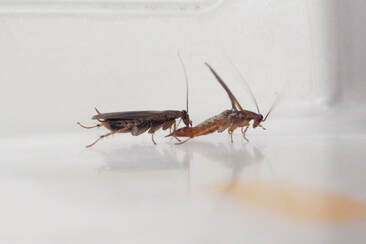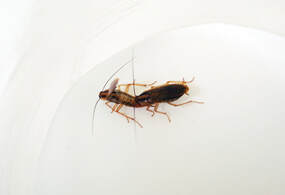|
Insecticide resistance can have troubling costs for insects. What happens when resistant insects start rejecting potential mates? Will the population revert back to susceptibility? Not necessarily. Read on to find out more about a unique, unintended consequence of behavioral insecticide resistance in a common urban pest. Previously, Bug Lessons mentioned how insecticide resistant German cockroaches started to avoid glucose (a type of sugar). Sugary, sweet baits used for managing these insects are also insecticidal. By avoiding sugar, the cockroaches ultimately also avoid the bait. Now, researchers have discovered that female cockroaches that avoid glucose (GA-females) often reject males attempting to mate. WHAT DOES SUGAR HAVE TO DO WITH COCKROACH MATING? Nuptial gifts are small “treats” that animals give to one another to help increase their chance of mating. (Think about that next time your partner gives you a box of chocolates.) This “gift-giving” practice is common in the insect world. For German cockroaches, males present females with a nuptial gift of body secretions that contain sugars and fats. This gift holds the female’s attention long enough for the males to mate.
However, the nuptial gift that males provide to females contains sugar. Researchers noticed that GA-females turn down the nuptial gift presented to them by most males. As a result, they are rejecting successful mating too. This is counter to what we would expect, since most insects must mate to survive. Why do these females reject the gift, especially since the sugars in the male nuptial gifts are not glucose? SOLVING THE PUZZLE To understand why females were leaving mating events early, researchers started matching up different pairs of cockroaches and observed what happened. Females that avoid glucose most often avoided mating with normal males. (Normal males do not avoid glucose.) However, GA-females feeding on nuptial gifts from males that also avoid glucose (GA-males) did not interrupt mating as quickly.
FINAL THOUGHTS The insecticides we use for pest management can affect both the behavior and physiology of insect populations. We need to understand exactly how we are modifying populations with insecticides because unintended consequences that make pest management more difficult can occur. According to Dr. Coby Schal, an author on the study, “We are constantly in an evolutionary battle with cockroaches. Evolution can be sped up tremendously in the urban, human environment because the selection force imposed on insects, especially inside homes, is so intense.” This study provides yet another timely reminder of the importance of science-based pest management to delay insecticide resistance and other possible unintended consequences.
0 Comments
Plantlife’s No Mow May™ campaign launched again this year on April 29th, 2022. Advocates of the movement claim that you can do more for pollinators by doing less—just lock up your mower for the entire month. However, does letting your lawn go for one month actually help pollinators? What exactly does the campaign entail, and should you get involved? Read on to hear what all the “buzz” is about. Plantlife, a wild plant conservation charity based in the United Kingdom, has asked citizens in the United Kingdom to put away their lawn mowers each May in an effort to increase forage (habitat with food) for pollinators, especially bees. Advocates of the movement encourage members of the community to allow their lawn to grow freely early in the spring (May) so that smaller plants like dandelions and clover can flower. They maintain that this allows pollinators to have a “leg up” on generating their nectar reserves. At the end of May, when the initiative closes, Plantlife encourages participants to complete the “Every Flower Counts” survey. Survey organizers state that the questionnaire serves as a pollinator “health-check” for the participant by assessing:
As an added participation bonus, each participant receives a unique “Personal Nectar Score”, which is meant to be a reflection of how many pollinators the participant’s lawn can feasibly support. The higher your score, the more pollinator-friendly your lawn is. Plantife has made multiple claims in their “press pack” that communicate the benefit of the program to pollinator health, including:
Pollinators add an estimated $18 billion dollars in crop revenue—their importance in food production should not be understated or underappreciated. The global concern for pollinator health and maintenance is likely one reason why the No Mow May movement has some traction here in the US as well. Outlets like NPR, The Guardian, and The New York Times reported on the phenomenon this year. Our participation is not entirely new—adoption of the program in the US began in Appleton, Wisconsin in 2020. The result? No Mow May lawns had better bee diversity and abundance versus manicured lawns. In addition, the rusty patched bumble bee, which has been endangered since 2017, was observed in Appleton again for the first time last year. With promising results like these, it is tempting to think that the No Mo May has no downside, right? Not so fast. Some horticultural educators, such as Pamela Corle-Bennet at The Ohio State University, claim that neglecting mowing for an entire month could kill the grass and encourage weed growth that may increase pesticide use. Additionally, she claims that May might not be the ideal month for nectar-rich plants like clover to bloom in certain geographical areas. For instance she states that in Ohio, clover starts to bloom in June. Griffin Dill, the manager of a laboratory at the University of Maine has concerns about No Mow May, too, but for a different reason—ticks. He worries that the environment that promotes pollinator livelihood would also increase the number of tick encounters they observe in Maine. Bangor Daily News states: “In a perfect world, homeowners could manage yards for tick control and promote pollinator habitat. It’s the unfortunate reality that you can’t do both.” For the record, Bangor is a city in Maine. If you want to protect pollinators this season without encouraging tick presence or risking the health of your grass, the best solution might be to find some middle ground (no pun intended). A nice compromise could be mowing less across the entire flowering season. Research shows that mowing every two weeks could increase the quantity of bees in the landscape. Mowing less often but not stopping altogether also prevents bees from having issues accessing blooms, which can be a concern if grasses are too long. As an alternative, Plantlife suggests having areas where grass is shorter complimented by areas where the lawn can grow a little taller, if possible. To reduce the presence of ticks, shorter grassy areas should be adjacent/closest to where humans walk around the most. If the idea of an ‘untidy’ lawn really does not appeal to you or you are restricted by local ordinances, you can still augment pollinator forage by designing a pollinator garden filled with bee- and other insect- friendly plants. The United States Forest Service provides excellent guidance for designing a pollinator garden. You can also reach out to local Master Gardeners and Extension Specialists in your area who may be able to make suggestions tailored to your particular region. Finally, if using herbicides or insecticides in the landscape, always use them according to the label and do not spray on blooms where bees are visiting. This is especially important in the spring and summer when pollinators are exceptionally active. Ultimately, there are very few downsides to maintaining a pollinator-friendly yard and trying to improve pollinator diversity and abundance is a worthwhile endeavor. However, the way you decide to support pollinator abundance is a personal choice. Whether you mow less, not at all, or put out a pollinator-friendly garden—minimal or even no effort could help pollinating insects in a major way this season. You may have noticed media reports on this very large spider. Are you getting more questions from customers afraid of spiders falling from the sky? Have you thought, “should I be worried about this”? Experts agree that people should not fear this gentle giant. A little bit of knowledge can help calm down worries and equip you to answer questions you may get about the joro spider. For many of us across the U.S., spring has arrived with some much needed sunshine and warm weather. Unfortunately, rising temperatures have also triggered the emergence of some undesirable 6 and 8 legged creatures. Along the east coast, this includes the presence of a new, menacing looking spider. But do not be afraid, looks can be deceiving. Coined the ‘joro spider’ (Trichonephila clavata), this palm-sized arachnid (another term scientists use for spider) invaded from Japan and took up residence in Georgia back in 2014. Recently, a scientific publication claimed that this species had the potential to invade the entire east coast due to its cold hardiness versus other related, native species. The popular press really ran with the finding, crafting sensationalized headlines to warn the public that large spiders would soon be literally “falling from the sky”—pushing the joro spider into the limelight, most likely, undeservedly. Joro spiders are native to Japan and eastern Asia, and experts think they entered the U.S. in shipping containers. Using websites such as https://www.inaturalist.org/, which allows citizens to report sightings of joro spiders, scientists estimate the current range of this invasive species to be somewhere around 15,500 square miles.
In spite of a striking appearance (in Japanese folklore, the joro spider turns into a striking woman to prey on unsuspecting men), they do not harm humans or animals and are considered a very passive spider. Although you probably should not handle one, bites are unlikely. Additionally, experts have found that this species has little to no effect on regional agricultural practices or ecosystem functions. They might even be beneficial, as they feed on some pest insects, and might serve as an additional food source for birds and other predators. Thus, unlike other more destructive invasive insects, spiders, and ticks you may have heard of (e.g., spotted lanternflies, fire ants, brown marmorated stink bugs, and Asian longhorned ticks) researchers think the best thing to do with this spider is simply leave it alone. Right now, there have been joro spider sightings in Georgia, Tennessee, South Carolina, North Carolina, and Oklahoma. They can easily move due to human activity and travel. Time will tell how far they will establish, but over the next decade or so, researchers estimate that the spider’s range will increase in all directions due to their ability to withstand milder climates. There is no reason to kill these spiders when you see them. Although if you see one outside reported ranges, you could report it to help scientists map their spread throughout the U.S. Additionally if you need assistance with identification, you can work with an extension specialist at a major academic university in your state. You may be tempted to kill spiders when you see them, especially non-native, giant ones that look threatening. However, try not to judge a book by its cover here. This may be a lucky situation where an invasive species actually benefits the area it inhabits. Let’s hope so because, like it or not, it looks like joro spiders are here to stay. For more information on joro spiders, check out this nice article by The Washington Post. |
Bug Lessons BlogWelcome science communicators and bug nerds!
Interested in being a guest blogger?
Archives
November 2023
Categories
All
|





